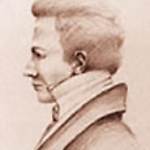Person
Dawes, William (1762 - 1836)

William Dawes
Details
- Born
- 1762
England - Died
- 1836
Antigua - Occupation
- Astronomer and Surveyor
Summary
William Dawes, an officer of the marines, came to Australia with the First Fleet in 1788 and established an observatory at Sydney on behalf of the British Board of Longitude.
Details
Dawes arrived in Australia with the First Fleet as a Lieutenant in the Royal Marines, having served in the American War of Independence, and subsequently pursued studies in engineering and surveying. Equipped with meteorological and astronomical books and instruments provided by the Royal Astronomer, he immediately began construction of an observatory at what is now known as Dawes Point, near the southern pylon of the Harbour Bridge. Dawes' meteorological journal provides a detailed chronology of the early weather of the colony from September 1788 until his departure for England in December 1791. A Hundred Years of Science and Service, Bureau of Meteorology, 2001.
Related entries
Archival resources
Mitchell and Dixson Libraries Manuscripts Collection, State Library of New South Wales
- William Dawes - Records, 1788 - 1836; Mitchell and Dixson Libraries Manuscripts Collection, State Library of New South Wales. Details
Published resources
Books
- de Grijs, Richard and Jacob, Andrew, William Dawes: scientist governor, abolitionist: caught between science and religion (Cham, Switzeland: Springer, 2023), 272 pp. Details
- Gibson, Ross, 26 Views of the Starburst World: William Dawes at Sydney Cove 1788-91 (Crawley, W.A.: UWA Publishing, 2012), 290 pp. Details
- Nathan, D., William Dawes' notebooks on the Aboriginal language of Sydney, 1790-1791 (London: Hans Rausing Endangered Language Project and SOAS Library Special Collections, School of Oriental and African Studies, 2009), 80 pp. Details
Book Sections
- Howse, Derek, 'William Dawes, 1762-1836' in Oxford Dictionary of National Biography (Oxford: Oxford University Press, 2004). Details
- Mander-Jones, Phyllis, 'Dawes, William (1762-1836), officer of marines, scientist and adminstrator' in Australian dictionary of biography, volume 1: 1788 - 1850 A-H, Douglas Pike, ed. (Melbourne: Melbourne University Press, 1966), pp. 297-298. http://www.adb.online.anu.edu.au/biogs/A010282b.htm. Details
Conference Papers
- Bosloper, Case, 'William Dawes' Gravity Measurement in Sydney Cove, 1788', in FIG Congress 2010: Facing the Challenges - Building the Capacity, Sydney, Australia 11-16 April 2010: TS 6M History of Surveying (2010), p. 14., http://fig.net/pub/fig2010/papers/ts05/ts05f_bosloper_4534.pdf. Details
Edited Books
- Engineers Australia ed., Anything is possible: 100 Australian engineering leaders (Barton, A.C.T.: Institution of Engineers, Australia, 2019), 136 pp. 'A true pioneer - William Dawes' p.4. Details
Journal Articles
- de Grijs, Richard, 'Gravitational conundrum: confusing clock-rate measurements on the "First Fleet" from England to Australia', Journal of astronomical history and heritage, 25 (4) (2022), 737-44. Details
- Grijs, Richard de, 'The unexpected appearance of Dawes' observatory on the "1808 Sydney Cove map"', Journal of astronomical history and heritage, 25 (1) (2022), 83-90. Details
- Grijs, Richard de; and Jacob, Andrew P., 'William Dawes: practical astronomy on the "First Fleet" from England to Australia', Journal of astronomical history and heritage, 24 (1) (2021), 7-40. Details
- Grijs, Richard de; and Jacob, Andrew P., 'Sydney's scientific beginnings: William Dawes' observatories in context', Journal of astronomical history and heritage, 24 (1) (2021), 41-73. Details
- Laurie, P. S., 'William Dawes, and Australia's First Observatory', Quarterly Journal of the Royal Astronomical Society, 29 (1988), 469-482. Details
- Marriott, R. A., 'W. Dawes and W. R. Dawes', Journal of the British Astronomical Association, 97 (1986), 10. Details
- Morrison, Doug and Barko, Ivan, 'Dagelet and Dawes: their Meeting, their Instruments and the First Scientific Experiments on Australian Soil ', Historical Records of Australian Science, 20 (1) (2009), 1-40, https://doi.org/10.1071/HR09002. Details
- Orchiston, W., 'William Dawes: Australia's First Meteorologist', Quarterly Journal of the Royal Astronomical Society, 30 (1989), 359-360. Details
- Russell, H.C., 'Astronomical and Meteorological Workers in New South Wales, 1778-1860', Report of the first meeting of the Australasian Association for the Advancement of Science, 1 (1888), 45-94, https://www.biodiversitylibrary.org/page/15813133. Details
Resources
- VIAF - Virtual International Authority File, OCLC, https://viaf.org/viaf/55503463. Details
- Wikidata, http://www.wikidata.org/entity/Q8007674. Details
- 'Dawes, William (1762-1836)', Trove, National Library of Australia, 2009, https://nla.gov.au/nla.party-616869. Details
Reviews
- de Grijs, Richard and Jacob, Andrew, William Dawes: scientist governor, abolitionist: caught between science and religion (2024)
Lomb, Nick, Journal of astronomical history and heritage, 27 (1), (2024), 228-30. Details - Gibson, Ross, 26 Views of the Starburst World: William Dawes at Sydney Cove 1788-91 (2012)
Nugent, Maria, Australian Historical Studies, 44, (2013), 295-7. Details
Theses
- Clarke, Robert Michael, 'Vanguards of empire: the lives of William Dawes, Watkin Tench and George Worgan', PhD thesis, Research School of Humanities and Arts, The Australian National University, 2015, 298 pp. Details
See also
- Federation and Meteorology, 2001, http://www.austehc.unimelb.edu.au/fam/index_d.html. Details
- Serle, Percival, Dictionary of Australian biography (Sydney: Angus & Robertson, 1949). Details
Digital resources
McCarthy, G.J.
Created: 20 October 1993, Last modified: 4 July 2012
- Current Supporter - National Council for the Centenary of Federation
- Foundation Supporter - Committee to Review Australian Studies in Tertiary Education
